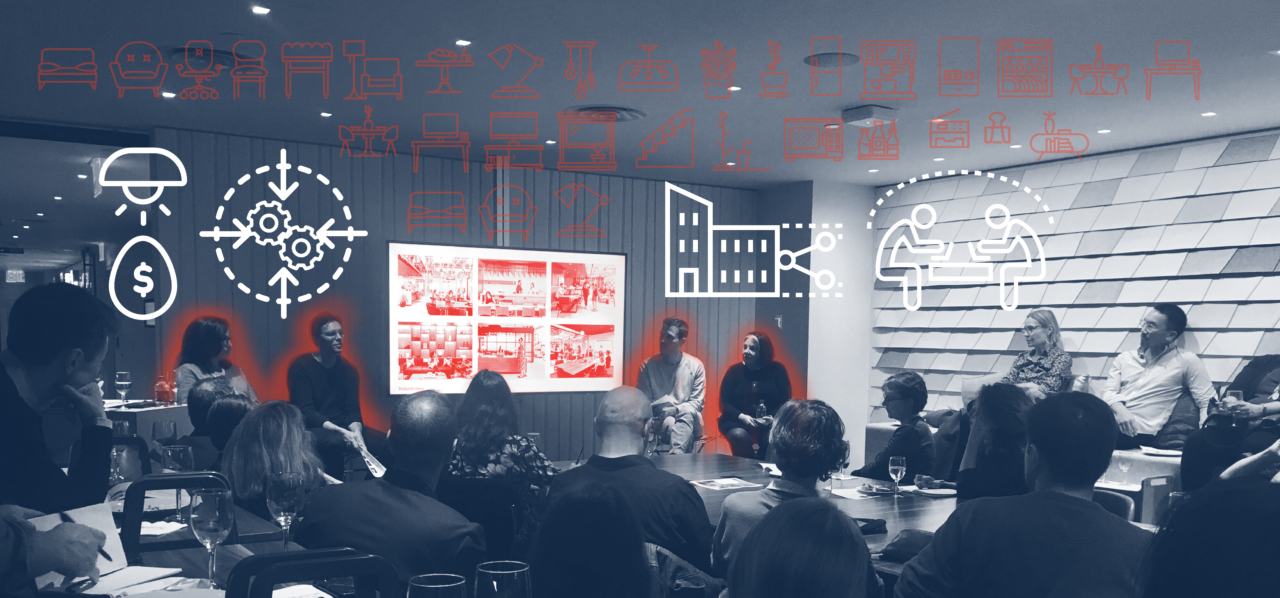-
October 30, 2018AIA Coworking Panelists Talk Trends
 Panelists discuss the evolution of coworking practice.
Panelists discuss the evolution of coworking practice.While coworking may be associated with large open desk areas and scrappy, early-stage startups, shared space has grown up, requiring more sophisticated design, measurement, and marketing, a panel of experts told AIA members and guests at a panel in on October 23.
A confluence of trends, including people seeking choice in how, when and where they work; corporate need for short and long-term flexibility; the miniaturization and portability of technology; and Millennials desiring to work in environments reminiscent of their recent college experience, has changed the landscape, according to Joyce Bromberg, chief strategy officer at Convene, a New York City-based network of meeting, event and flexible workspaces.
Coworking has evolved into a new way to provide workplace for enterprise-level clients, explained Bromberg, whose firm provides solutions for groups of 10 to 100 people.
Everything that we know about landlords and how workplaces are designed, built, managed, and staffed is being disrupted, necessitating a new name for what Bromberg predicts will become the way people work and how real estate will be consumed.
As a fundamental part of the shared economy, coworking embodies the notions of access and pay-for-what-you-use, while incorporating shorter lease terms and an added layer of service and hospitality that ultimately empowers the provider, according to Eivind Karlsen, head of design at Industrious.
“We’re challenged to make sure that every day employees come into work we create a service that satisfies them, or they can move to another operator,” Karlsen said. “That’s a fairly new dynamic. You’re giving the occupier that key that they didn’t previously have.”
For the corporate occupant, it has led to more purposeful decision-making about where to locate particular groups and departments, according to Lucia Diana, global real estate for Verizon.
Moderator Melissa Marsh, founder of PLASTARC, summarized: “The definition of coworking is about how people work and how the real estate, design and construction industry deliver that product in a more systematic or productized way.” It’s also:
- A way of working with people in more diverse environments
- Co-locating people in different companies
- A way of delivering hospitality-driven office environment as a service
- Flexibility
- Speed of change from real estate and demand side
- Redefining corporate intellectual property boundaries from defense to offensive
Panelists also discussed the vicissitudes of generic and unique approaches to flexible space products and considered ways coworking is evolving toward a hospitality-style model with varied market segments, brands and levels of service.
Challenges with measurement were something all panelists experienced in the flexible office model where “people vote with their feet.”
While many providers are investing in various sensor-style products, challenges lie in mandating adoption.
“Any tool is only as good as the number of people that use it,” said Bromberg.
At Verizon, where the focus is on measuring utilization and measurement with retail-style people-counters, real data helps analyze and resolve situations such as a 25-person room occupied by three people, Diana described.
While data drives much of the decision-making and programmatic allocation of space that follows, great value can be derived from non-quantitative measurements, according to Karlsen, whose firm has found the community manager relationship to be a particularly valuable gauge.
“Getting those qualitative touch points on a daily basis inform how that member is experiencing that space, what challenges they have, where we can help provide a better day at work,” he added.
And in some cases, it’s the space itself that signals a successful project, as the Rockwell Group’s Matthew Winter explained.
Describing a corporate office project that consolidated six groups under one roof, he noted that only a small percentage of individuals were allowed to keep private offices. Some departments opted for a purely democratic experience, with executives moving into open spaces with their teams, while others fought hard to keep a disproportionate number of offices.
For open offices, shared spaces and ancillary lounges, Rockwell’s design features a hospitality-focused center-hearth approach.
“The true measurement of the success of this project will be if at the end of it, some of the EVPs and SVPs are not spending time in the office they fought so hard for, and instead holding court in one of those lounges,” noted Winter.
Coworking was the second in a two-part workplace series presented by the Interiors, Marketing & Communications and Social Science and Architecture committees of the New York City chapter of the AIA. On May 2, the committee presented Workplace Design Part 1 exploring how marketing the physical work environment can attract and retain talent.
###
This post was sponsored by PLASTARC.
Social Science and Architecture
The Social Science and Architecture Committee was formed in January 2016 with the goal of bringing together professionals and students from architecture, social science, and other fields to discuss, collaborate, and facilitate programs for the community. The meeting offers a place to exchange ideas related to social science and architecture, address topics of interest to the attendees, and to plan AIA panels on related topics. The Committee meets monthly and is open to anyone who would like to attend. Meetings are held the fourth Friday of every month from 8:30–10:00 AM.







